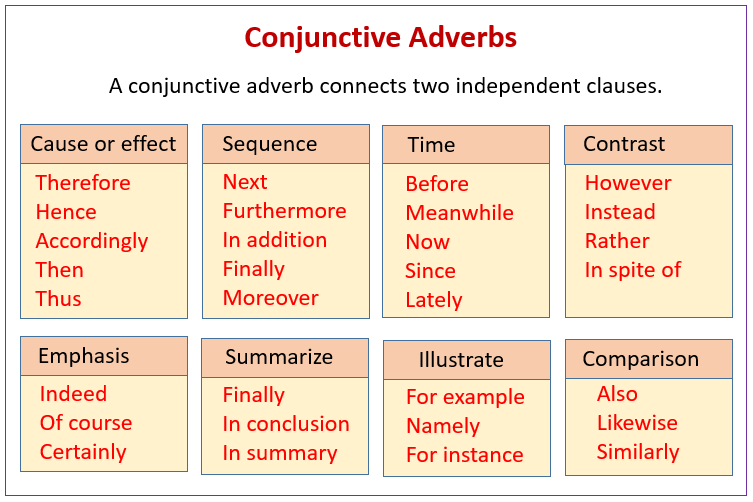Conjunctive Adverbs
Welcome to our collection of English as a Second Language (ESL) tools & resources for students, teachers, and educators.
We have lots of free videos that will help you improve your English and also advice and tips that will help you in English proficiency examinations like TOEFL and IELTS.
What are Conjunctive Adverbs?
They are words that connect two independent clauses. They show cause or effect, sequence, contrast or comparison relationships.
Some examples of conjunctive adverbs are: however, moreover, finally, furthermore, likewise, instead, therefore, likewise, instead, therefore, still, meanwhile, accordingly, nevertheless, also.
The following diagram gives some examples of conjunctive adverbs. Scroll down the page for more examples and solutions.

How are they used?
- The beginning of a sentence.
CA , SS - The middle of a sentence
SS ; CA , SS
When are they used?
To show a specific type of relationship between two simple sentence.
Conjunctive Adverbs
Conjoiners, Conjunctive Adverbs
This lesson defines conjunctive adverbs and explains how they can be used as transitions in writing. It also gets into how to use commas and semicolons with conjunctive adverbs to help students develop a smoother writing voice.
Conjunctive Adverbs, Part 1
What are conjunctive adverbs? When are they used? How are they used?
Conjunctive Adverbs, Part 2
What are conjunctive adverbs? When are they used? How are they used?
Try out our new and fun Fraction Concoction Game.
Add and subtract fractions to make exciting fraction concoctions following a recipe. There are four levels of difficulty: Easy, medium, hard and insane. Practice the basics of fraction addition and subtraction or challenge yourself with the insane level.

We welcome your feedback, comments and questions about this site or page. Please submit your feedback or enquiries via our Feedback page.